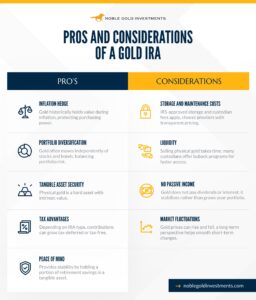A gold IRA is a retirement account that holds physical gold and other precious metals. Because of persistent inflation, market volatility, and a renewed focus on portfolio diversification, this unique investment is trending.
Is gold IRA a good investment? In this article, we’ll take a deep dive into how gold IRAs work, what their pros and cons are, how to buy physical gold, and how to determine whether a gold IRA is the right retirement account for you.
What Is a Gold IRA & How Does It Work?
A gold IRA is a self-directed IRA holding physical precious metals. Although “gold” is the only metal included in the name, a gold IRA lets you invest in any of the following:
- Gold
- Silver
- Palladium
- Platinum
How does gold IRA work? When you invest in gold through an IRA, your money purchases actual precious metals. However, because you’re funding a retirement account (as opposed to simply buying gold), the process is tightly regulated by the IRS.
The IRS only allows you to fund your gold IRA with certain types of gold and other metals. All metals must meet high standards for fineness (purity), and your IRA may not include graded coins, collectible coins, or jewelry.
You can’t take gold you already own and put it in a gold IRA. Funding your gold IRA involves working with three key players:
- Custodian: The financial institution managing your IRA
- Dealer: The company that sells you the IRS-approved metals
- Depository: The IRS-approved facility that stores your gold
The IRS doesn’t allow you to have physical control of the gold in your IRA. When funding your IRA, you transfer funds to the custodian, who buys the gold you’ve selected from a dealer. The dealer ships the gold to the depository of your choice.
Your gold IRA doesn’t pay dividends or interest. Instead, the total value of your account grows as the market price of precious metals increases. Depending on the specific type of gold IRA you have, that growth may be tax-free or tax-deferred.
Want personalized guidance on whether a gold IRA fits your retirement plan? Schedule a complimentary gold investing strategy session with Noble Gold today.

The Three Types of Gold IRAs
If you’re considering opening a gold IRA, you have three options to choose from. The tax treatment of your investment is determined by your account type:
Traditional Gold IRA
You contribute to a traditional gold IRA with pre-tax dollars, and you pay tax on withdrawals. As is the case with other traditional IRAs, you must take required minimum distributions (RMDs) from the account once you reach a certain age. Currently, you must begin taking RMDs at age 73.
Roth Gold IRA
With a Roth gold IRA, you contribute post-tax dollars, and withdrawals are tax-free. Just as with any other Roth IRA, there are no required minimum distributions.
SEP Gold IRA
A SEP-IRA (Simplified Employee Pension Individual Retirement Account) is a type of IRA designed for self-employed people and business owners. A SEP gold IRA has higher contribution limits than traditional and Roth gold IRAs.
When you contribute to a SEP gold IRA, you do so with pre-tax dollars. This means that withdrawals are taxed, and you must take RMDs.
How to Invest in a Gold IRA: Step-by-Step Guide
Wondering how to invest in gold IRA accounts? Here’s a quick guide:
Step 1: Choose a Reputable Custodian
The first step is choosing the right custodian for your account. There are many available options, but they aren’t all the same. Because of the time, expense, and logistics involved, gold IRA custodians charge fees, and some fees are higher than others. It’s important to look for transparency, clear communication, and insurance options.
Noble Gold partners with IRS-approved custodians, and when you work with us, we can help you connect with the right one for you. We’ve helped our customers secure their financial futures for more than 20 years, and our testimonials speak for themselves!
Step 2: Fund Your Account
Once you have selected a self-directed IRA custodian, you can begin the process of funding your account. You have two options for doing so:
- Rollover: Transfer funds from a 401(k) or other retirement account
- Direct Contribution: Make a new contribution from a bank account
Keep in mind that if you’re making a new contribution, you may only contribute up to the annual limit set by the IRS. For a traditional or Roth gold IRA, you can contribute up to $7,000 if you’re under 50 and up to $8,000 if you’re 50 or older. For a SEP gold IRA, you may contribute either 20% of your net annual earnings or $70,000, whichever is less. The IRS adjusts contribution limits each year. These are the limits for 2025.
Step 3: Select Metals to Purchase
The next step is identifying which metals to purchase. You may put coins, bullion, or bars in a gold IRA, but the IRS only approves certain types. Graded and collectible coins may not be used to fund an IRA, and the IRS allows only coins made by government mints. Bars and bullion must come from accredited manufacturers.
All metals must meet these purity standards:
- Gold: 99.5%
- Silver: 99.9%
- Platinum: 99.95%
- Palladium: 99.95%
There is one notable exception to the gold purity standard. The American Gold Eagle coin has a 91.67% purity, but the IRS explicitly allows it to be included in gold IRAs.
Step 4: Purchase Your Metals
Wondering how to purchase gold to place in your IRA? To ensure compliance with IRS rules, you’ll need to fill out an investment direction form with your custodian. The form identifies the specific coins, bars, and/or bullion you want to buy and authorizes the custodian to purchase them using funds from your account.
Step 5: Arrange Storage
Because gold for an IRA cannot be shipped directly to you, the dealer will need to ship it to a secure storage facility. Your custodian can help you select an IRS-approved depository.
Once the custodian purchases the gold on your behalf, the dealer will ship your gold straight to the depository. The depository will verify the gold’s purity upon arrival and notify your custodian.
Step 6: Manage and Monitor
Once your gold IRA has been set up, you should monitor it like you would any other investment. You should receive monthly statements from the custodian, and you’ll likely be able to monitor your account online, too.
Download our free Gold and Silver Investment Guide for a detailed checklist to help you navigate every step of the process.
Buying Physical Gold vs. Buying Gold Through an IRA
The process of buying gold through an IRA is complex, so you might wonder whether you should just buy physical gold yourself.
When you buy physical gold yourself, you can have it delivered to your home, and you don’t have to limit yourself to the IRS-approved options needed for gold IRAs. You also won’t incur the ongoing maintenance fees of a gold IRA.
However, buying gold yourself doesn’t come with the tax advantages of a gold IRA. It also comes with potential risks:
- Disreputable dealers may sell you counterfeit gold
- Keeping gold in your home carries a risk of theft
- Secure storage comes with storage fees
- Physical metals have limited liquidity
How do you buy physical gold outside of a gold IRA? The process is somewhat similar, but it’s also far more hands-on:
- Research and find a trusted dealer
- Choose your gold and make a purchase
- Verify the purity of the gold when it arrives
- Choose a secure storage facility
- Purchase insurance coverage
If you’re not sure how to purchase gold as a personal investment, get in touch with Noble Gold. We can help!
Pros of a Gold IRA
Many people who open gold IRAs do so because of advantages like these:
Hedge Against Inflation
Over the course of history, gold has consistently maintained value during periods of inflation. This helps protect your purchasing power.
Portfolio Diversification
Gold’s performance isn’t typically correlated with stocks, bonds, mutual funds, or other asset classes.
Tangible Asset Security
Many investors find comfort in the fact that gold is an asset with intrinsic value. When the market is volatile, owning physical gold can give you a sense of security.
Tax Advantages
Each type of gold IRA comes with tax advantages. Depending on the type you choose, you can benefit from tax-free or tax-deferred growth.
Peace of Mind
You shouldn’t put all of your retirement funds into a single asset. However, keeping a portion of your savings in gold or other physical assets can give you priceless peace of mind.
Considerations to Keep in Mind
Every investment has its potential downsides. Before you commit to a gold or precious metals IRA, take some time to weigh these special considerations:
Costs for Storage and Maintenance
Many kinds of investments come with fees. However, the fees for gold IRAs are higher than most. This is because the precious metals in a gold IRA must be held in an IRS-approved storage facility. They also must be managed by a professional custodian.
Tip: You can’t completely avoid fees with a gold IRA, but you can avoid paying more than you have to. When choosing a custodian, select one with transparent pricing so you know what to expect.
Liquidity Can Take Time
When you need to liquidate stocks or ETFs, you can often do so almost instantly. Physical gold isn’t entirely illiquid, but liquidating it takes more time.
Tip: Worried about liquidity? Many custodians offer buyback programs to make it faster and easier for their clients to liquidate.
No Passive Income
Unlike some other investments, a gold IRA won’t generate passive income through interest or dividends.
Tip: Think of a gold IRA as a portfolio stabilizer. While it may not be a major growth engine, it offers a degree of security that higher-return assets cannot.
Market Fluctuations
Although gold is an asset that tends to retain value over time, its prices still fluctuate.
Tip: Don’t be too concerned with short-term changes in the price of gold. When investing in gold, it’s best to take a long-term perspective.
Common Mistakes to Avoid
Gold IRAs can offer you considerable advantages. However, if you decide to open one, be careful to avoid these common pitfalls:
- Buying from an unverified dealer
- Choosing a custodian with hidden fees
- Not understanding IRS storage requirements
- Putting too much of your retirement savings toward gold
- Not understanding the tax advantages and consequences of each type of IRA
- Not taking your liquidity needs into account
Get expert guidance before you invest. Schedule a complimentary session to review your strategy.
FAQ
Why Is Gold Such a Popular Investment Strategy for Retirement Planning?
Gold plays a role in many people’s retirement plans for several reasons. It’s a proven hedge against inflation, it retains value in economic downturns, and it’s an effective way to diversify an investment portfolio.
What Are the Advantages of Investing in a Gold IRA Versus Other Types of Investments, Like Stocks or Bonds?
A gold IRA is one of the best investments for inflation protection, as gold is historically less volatile than stocks and bonds. When you invest in gold through an IRA, you also enjoy tax advantages you can’t get with stocks or bonds.
Are Gold IRAs a Safe Investment During Economic Downturns?
In many cases, yes. Gold is a “safe haven” asset, and it tends to hold value or increase in value during times of economic uncertainty. However, like other investment options, it’s not without risks.
How Much Can I Contribute to a Gold IRA?
That depends on the IRA type. For 2025, you can contribute up to $7,000 to a standard or Roth gold IRA if you are under 50 and up to $8,000 if you are 50 or older. If you have a gold SEP IRA, you can contribute the lesser of $70,000 or 20% of your net earnings.
Can I Roll Over My 401(k) Into a Gold IRA?
Yes. To do this, you must roll the funds directly to a self-directed IRA and instruct your IRA custodian to purchase gold from a particular dealer.
What Kind of Gold Can I Buy?
The IRS only allows gold IRAs to include coins, bars, and bullion of very high purity. Gold for your IRA must be purchased through your custodian.
Can I Keep the Gold at Home?
No. IRS regulations require that any gold purchased for your gold IRA must be kept in an IRS-approved vault or depository.
Is It Better to Buy Physical Gold or Invest Through a Gold IRA?
That depends on your individual goals and preferences. Buying through a gold IRA comes with tax benefits, and you don’t have to arrange storage yourself. Buying physical gold gives you immediate access and more control, but it doesn’t come with the tax benefits of a gold IRA.
Do You Pay Tax on a Gold IRA?
That depends. With a traditional gold IRA or a gold SEP IRA, you contribute with pre-tax dollars and pay tax on withdrawals. With a Roth gold IRA, you contribute with post-tax dollars, and withdrawals aren’t taxed.
What Happens if I Need to Liquidate Quickly?
If you want to liquidate your gold IRA, you’ll need to get in touch with your custodian. They will arrange for an approved dealer to purchase your gold.
Making the Decision: Is a Gold IRA the Right Investment?
Gold IRAs offer stability, tax benefits, and a proven hedge against inflation. However, if you open one, you must ensure compliance with IRS rules and cover storage, maintenance, transaction, and setup fees.
For some, a gold IRA is an excellent choice of investment. However, before opening one, it’s critically important to do your due diligence.
Doing research on your own is valuable, but don’t discount the importance of professional advice. Working with a financial advisor or other financial professional can help you make the right decision for your financial goals.
Ready to take the first step? Open an account today and start building a tangible, secure retirement portfolio.







